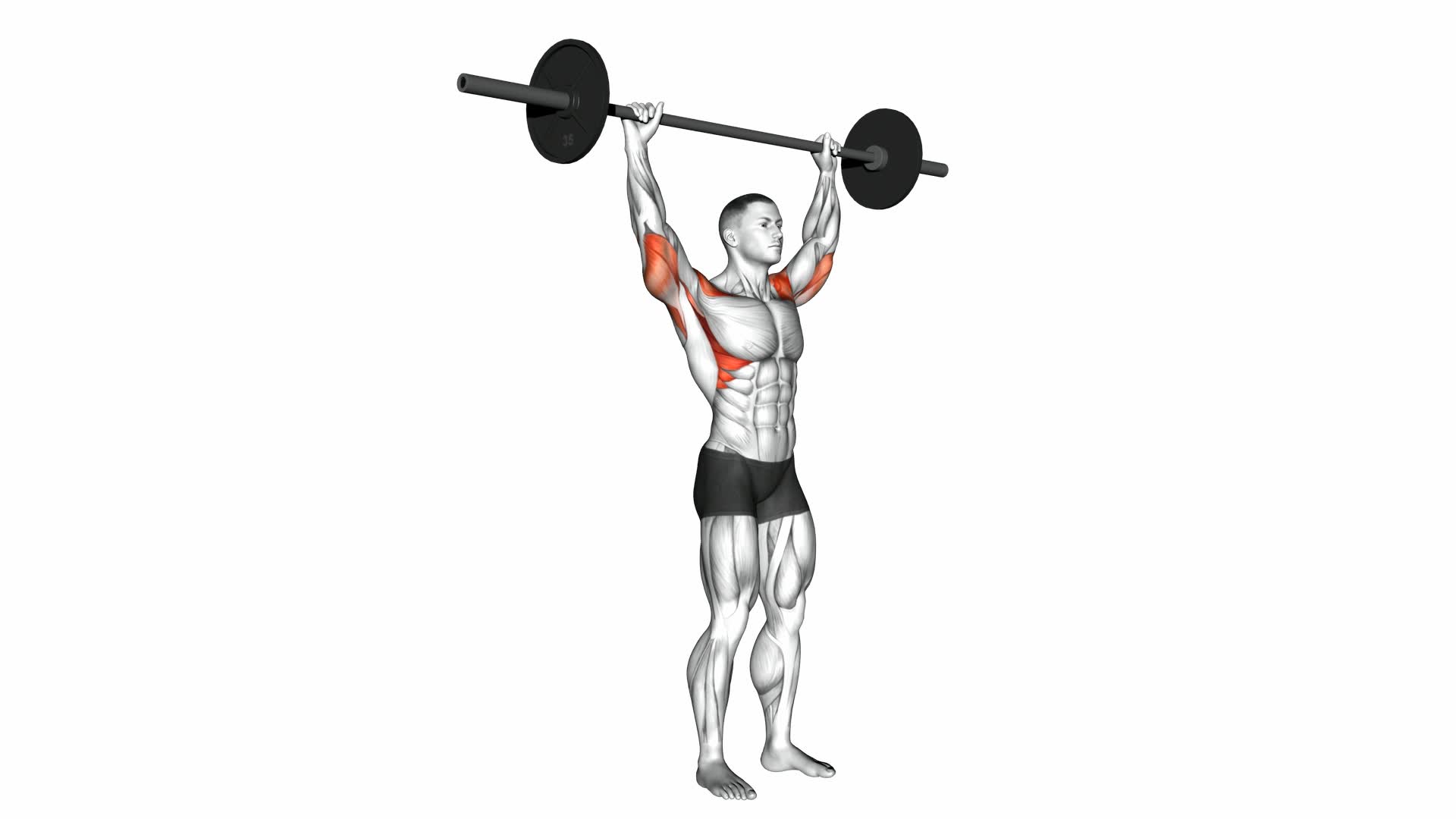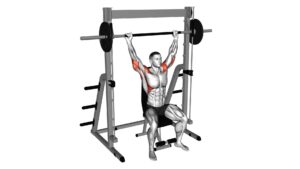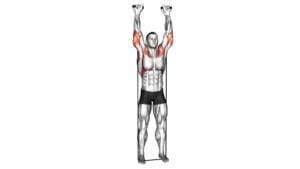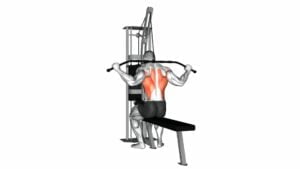Standing Behind Neck Press – Video Exercise Guide & Tips

Looking to level up your fitness routine? Check out this video exercise guide and tips for the Standing Behind Neck Press.
Watch This Exercise Video
This exercise offers a range of benefits, including strengthening your upper body and improving posture. You’ll only need a barbell and a bit of determination to get started. Follow our step-by-step guide to ensure proper form and avoid common mistakes.
Plus, we’ve included helpful tips to make the exercise more effective. Let’s get those gains!
Key Takeaways
- Targets muscles in the shoulders and upper back
- Strengthens and tones these areas
- Increases shoulder stability
- Improves posture
Benefits of the Standing Behind Neck Press
You can experience several benefits by incorporating the Standing Behind Neck Press into your workout routine. This exercise is known for its ability to improve your technique and provide various advantages for your overall fitness.
One of the main benefits is that it targets the muscles in your shoulders and upper back, helping to strengthen and tone these areas. By performing this exercise regularly, you can increase your shoulder stability and improve your posture. Additionally, the Standing Behind Neck Press engages your triceps and chest muscles, promoting upper body strength and development.
Another benefit of the Standing Behind Neck Press is that it can enhance your overall shoulder mobility. As you lower the weight behind your neck, you’re required to have a wider range of motion in your shoulders. This can help to improve your flexibility and prevent shoulder injuries.
Furthermore, incorporating the Standing Behind Neck Press into your workout routine can also contribute to the improvement of your core stability. To perform this exercise correctly, you need to engage your abdominal muscles to maintain proper posture and balance. This not only strengthens your core but also enhances your overall body control.
Equipment Needed for the Exercise
To perform the Standing Behind Neck Press, you’ll need a barbell and a weight rack. These are essential pieces of equipment that will allow you to safely and effectively execute the exercise. The barbell is used to hold the weights and provide resistance, while the weight rack provides stability and support.
When it comes to exercise variations, there are a few options you can explore. If you don’t have access to a barbell or a weight rack, you can try using dumbbells instead. Simply hold a dumbbell in each hand and position them at shoulder height, with your palms facing forward. From there, you can perform the pressing motion, bringing the dumbbells up and over your head.
Another alternative equipment option is using a resistance band. Attach the band to an anchor point above you, and hold onto the handles as you perform the pressing motion. This can be a great option for those who prefer a more portable and versatile equipment setup.
Remember to always choose equipment that’s appropriate for your fitness level and capabilities. It’s important to prioritize safety and proper form when performing the Standing Behind Neck Press or any other exercise variation.
Step-By-Step Guide to Perform the Exercise
To perform the Standing Behind Neck Press correctly, it’s important to focus on proper form techniques, avoid common mistakes, and understand the benefits of this exercise.
Maintaining a straight back, engaging your core, and keeping your elbows pointed forward are key elements of proper form.
Common mistakes to avoid include leaning too far forward, arching your back, and using excessive weight.
This exercise targets the shoulders, triceps, and upper back, helping to improve strength and stability in these areas.
Proper Form Techniques
Start by positioning the barbell behind your neck for the standing behind neck press exercise. To ensure proper form and technique, follow these steps:
- Stand with your feet shoulder-width apart and grasp the barbell with an overhand grip, slightly wider than shoulder-width apart. Lift the barbell from the rack and bring it down to the back of your shoulders, resting it on your traps.
- Keep your core engaged, chest lifted, and shoulders back throughout the exercise. Take a deep breath in before you begin the press. As you exhale, push the barbell up overhead, fully extending your arms.
- Inhale as you lower the weight back down to the starting position. Repeat the exercise for the desired number of reps, focusing on maintaining proper form and breathing techniques throughout.
- To progressively overload the exercise and continue making gains, gradually increase the weight or reps over time.
Common Mistakes to Avoid
Avoid improper grip placement when performing the standing behind neck press exercise. This is a common mistake that can lead to injuries if not corrected. To avoid this, make sure to grip the barbell with your hands shoulder-width apart and palms facing forward. This will provide you with a stable and secure grip throughout the exercise.
Additionally, it’s important to properly warm up before performing the standing behind neck press. This will help to increase blood flow to your muscles, loosen up your joints, and prevent injuries. A proper warm-up can include activities such as light cardio exercises, dynamic stretches, and mobility exercises.
By avoiding these common mistakes and incorporating proper warm-up techniques, you can ensure a safe and effective standing behind neck press workout.
Now let’s move on to the benefits of this exercise.
Benefits of This Exercise
To maximize the benefits of the standing behind neck press exercise, focus on maintaining proper form and engaging your core throughout the movement. This exercise offers various advantages, including:
- Increased shoulder strength and stability: The standing behind neck press targets the deltoids, trapezius, and triceps, helping to build strength and stability in the shoulders.
- Improved upper body muscle development: By engaging multiple muscle groups, such as the shoulders, chest, and upper back, this exercise promotes overall upper body muscle development.
- Enhanced core activation: To maintain balance and stability during the movement, you need to engage your core muscles, which can lead to improved core strength.
When performing the standing behind neck press, remember to use proper breathing techniques and gradually increase the weight or repetitions to incorporate progressive overload strategies. By doing so, you can continue to challenge your muscles and promote further strength gains.
Transitioning into the next section, it’s important to be aware of common mistakes to avoid while doing this exercise.
Common Mistakes to Avoid While Doing the Exercise
When performing the Standing Behind Neck Press exercise, it’s important to be mindful of common mistakes that can hinder your progress and potentially lead to injury. One of the most common mistakes is using improper technique. It’s crucial to maintain proper form throughout the exercise to prevent strain on your neck and shoulders. Avoid arching your back or tilting your head forward, as this can put unnecessary stress on your spine. Instead, keep your back straight and your head aligned with your spine.
Another common mistake to avoid is using too much weight. Gradually increase the weight as your strength improves, but be cautious not to overload yourself. Using excessive weight can compromise your form and increase the risk of injury. Start with a lower weight that allows you to maintain proper technique throughout the exercise.
Additionally, rushing through the exercise is another error to watch out for. Take your time to perform each repetition with control and focus. This will ensure that you engage the correct muscles and reduce the likelihood of strain or injury.
Tips to Maximize the Effectiveness of the Exercise
To maximize the effectiveness of the standing behind neck press, focus on your breathing techniques. Inhale deeply before starting the movement and exhale forcefully as you push the weight overhead.
Additionally, ensure proper form and alignment by keeping your core engaged, shoulders down, and neck neutral throughout the exercise.
Lastly, implement progressive overload strategies by gradually increasing the weight or repetitions to continually challenge your muscles and promote growth.
Breathing Techniques During Exercise
During exercise, focus on your breathing technique to maximize the effectiveness of the standing behind neck press. Proper breathing techniques not only help you maintain control and stability during the exercise but also ensure that your muscles receive an adequate supply of oxygen.
Here are some important tips to keep in mind:
- Breathe in through your nose and exhale through your mouth to optimize oxygen intake and carbon dioxide release.
- Coordinate your breath with the movement – inhale as you lower the weight and exhale as you press it overhead.
- Take deep breaths into your diaphragm, allowing your abdomen to expand and contract with each breath.
By implementing these breathing techniques, you can enhance the effectiveness of the standing behind neck press and reduce the risk of injury.
Now, let’s move on to the next section where we’ll discuss proper form and alignment during this exercise.
Proper Form and Alignment
To maximize the effectiveness of the standing behind neck press, it’s crucial to maintain proper form and alignment throughout the exercise. This not only helps prevent injuries but also ensures optimal muscle activation. Start by standing with your feet shoulder-width apart and your knees slightly bent. Keep your core engaged and your back straight throughout the movement.
As you press the barbell overhead, make sure to keep your elbows slightly in front of your body and avoid arching your back. This will help activate the muscles in your shoulders, triceps, and upper back more effectively. Remember to breathe properly and exhale as you press the barbell up.
Maintaining good form and alignment will allow you to target the intended muscles and achieve maximum results.
Now, let’s explore some progressive overload strategies to further enhance your workouts.
Progressive Overload Strategies
Maximize the effectiveness of the standing behind neck press with these progressive overload strategies.
To ensure continuous progress and avoid hitting a plateau, consider incorporating the following overload progression techniques:
- Increase the weight: Gradually increase the amount of weight you lift during each training session. This challenges your muscles and promotes strength gains.
- Adjust the repetitions and sets: Vary the number of repetitions and sets you perform. For example, increase the number of sets or decrease the rest time between sets to add intensity and stimulate muscle growth.
- Modify the exercise: Experiment with different exercise variations, such as using dumbbells instead of a barbell or performing the exercise on an incline bench. These modifications can target different muscle groups and provide new challenges.
Variations and Alternatives to the Standing Behind Neck Press
If you’re looking to switch up your shoulder workout, try incorporating variations and alternatives to the standing behind neck press. These variations and modifications can help target different muscle groups and add variety to your routine.
One alternative exercise to the standing behind neck press is the seated dumbbell press. Instead of standing, you sit on a bench with a back support. Hold a dumbbell in each hand at shoulder level, palms facing forward. Press the dumbbells overhead until your arms are fully extended, and then lower them back down to shoulder level.
Another variation is the Arnold press. Start with the dumbbells held at shoulder level, palms facing your body. As you press the dumbbells overhead, rotate your palms so they face forward at the top of the movement. Reverse the motion as you lower the dumbbells back to shoulder level.
For those looking to target the front delts, the front raise is a great option. Stand with your feet hip-width apart, holding a dumbbell in each hand with palms facing your body. Raise the dumbbells directly in front of you until they reach shoulder level, and then slowly lower them back down.
Incorporating these variations and alternatives to the standing behind neck press can help you engage different muscle groups and prevent plateaus in your shoulder workout routine. Remember to always use proper form and start with lighter weights before progressing to heavier ones.
Frequently Asked Questions
How Many Reps and Sets Should I Do for the Standing Behind Neck Press?
To maximize the benefits of the standing behind neck press for your shoulder health, it’s important to consider the number of reps and sets you perform.
While the optimal number may vary depending on your fitness level and goals, a good starting point is 3 sets of 8-12 reps.
This range allows you to challenge your muscles while maintaining proper form and preventing excessive fatigue.
Remember to listen to your body and gradually increase the weight and intensity as you progress.
Can the Standing Behind Neck Press Help Improve My Posture?
Yes, the standing behind neck press can help improve your posture. By strengthening the muscles in your upper back and shoulders, this exercise can help to correct rounded shoulders and forward head posture.
To reap the benefits, it’s important to perform the exercise with proper form. Keep your back straight, engage your core, and avoid excessive strain on your neck.
Remember to start with a weight that’s suitable for your fitness level and gradually increase as you get stronger.
Is It Safe to Perform the Standing Behind Neck Press if I Have a Previous Neck Injury?
If you have a previous neck injury, it may not be safe to perform the standing behind neck press. It’s important to take precautions to avoid further injury.
Instead, consider alternative exercises that target the same muscles without putting excessive strain on your neck. Consult with a healthcare professional or a certified trainer who can provide guidance and suggest exercises that will be safe and effective for you.
How Often Should I Incorporate the Standing Behind Neck Press Into My Workout Routine?
To determine the frequency of incorporating the standing behind neck press into your workout routine, consider your current fitness level and goals.
As a general guideline, aim for 2-3 sessions per week, allowing for adequate rest and recovery between workouts.
However, it’s important to listen to your body and make modifications as needed, especially if you have a previous neck injury.
Consult with a fitness professional for personalized advice and to ensure proper form and technique.
Can the Standing Behind Neck Press Help Increase My Shoulder Strength and Stability?
The standing behind neck press is a great exercise for improving shoulder strength and stability. By engaging the muscles in your shoulders, it helps to build strength and endurance, making them more stable during daily activities and workouts.
Additionally, this exercise also targets the muscles in your upper back and arms, providing a well-rounded workout.
Incorporating the standing behind neck press into your routine can have many benefits and contribute to overall shoulder stability and strength.
Conclusion
In conclusion, the standing behind neck press is a beneficial exercise that targets the shoulders, triceps, and upper back muscles. It requires minimal equipment and can be easily performed with proper form. By avoiding common mistakes and following the provided tips, you can maximize the effectiveness of this exercise.
Additionally, there are variations and alternatives available for those looking to switch up their routine. Incorporating the standing behind neck press into your workout regimen can help improve strength and muscle definition in the upper body.

Author
Years ago, the spark of my life’s passion ignited in my mind the moment I stepped into the local gym for the first time. The inaugural bead of perspiration, the initial endeavor, the very first surge of endorphins, and a sense of pride that washed over me post-workout marked the beginning of my deep-seated interest in strength sports, fitness, and sports nutrition. This very curiosity blossomed rapidly into a profound fascination, propelling me to earn a Master’s degree in Physical Education from the Academy of Physical Education in Krakow, followed by a Sports Manager diploma from the Jagiellonian University. My journey of growth led me to gain more specialized qualifications, such as being a certified personal trainer with a focus on sports dietetics, a lifeguard, and an instructor for wellness and corrective gymnastics. Theoretical knowledge paired seamlessly with practical experience, reinforcing my belief that the transformation of individuals under my guidance was also a reflection of my personal growth. This belief holds true even today. Each day, I strive to push the boundaries and explore new realms. These realms gently elevate me to greater heights. The unique combination of passion for my field and the continuous quest for growth fuels my drive to break new ground.







